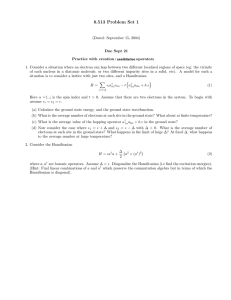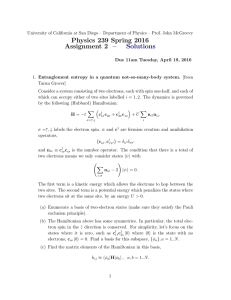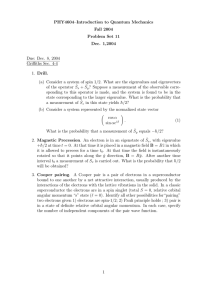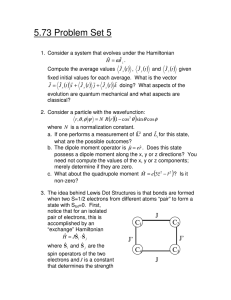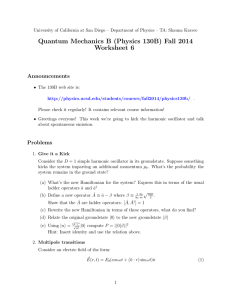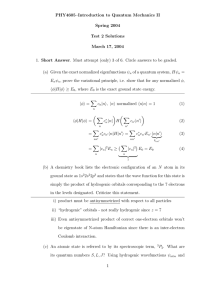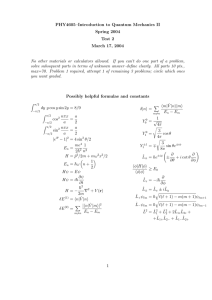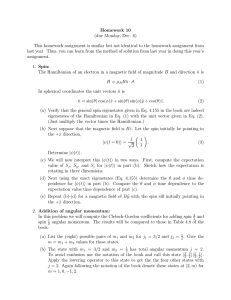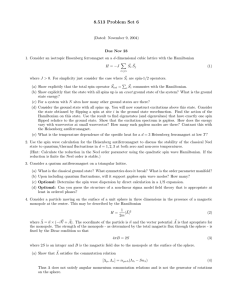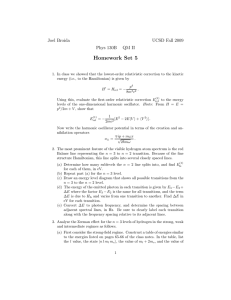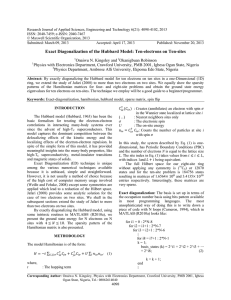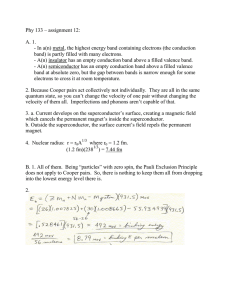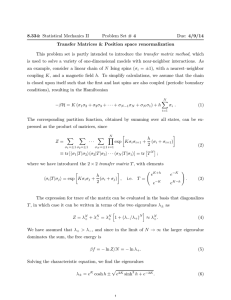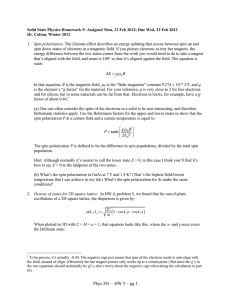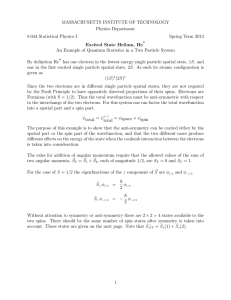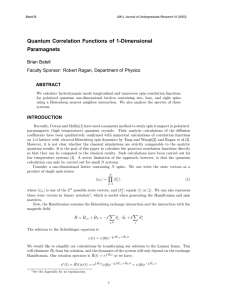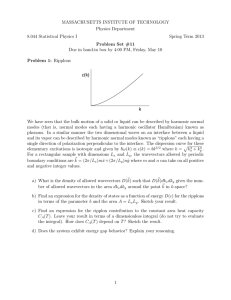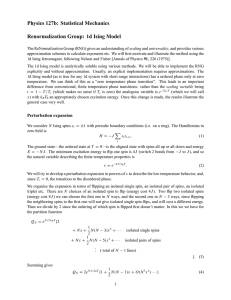Physics 239 Spring 2016 Assignment 2
advertisement
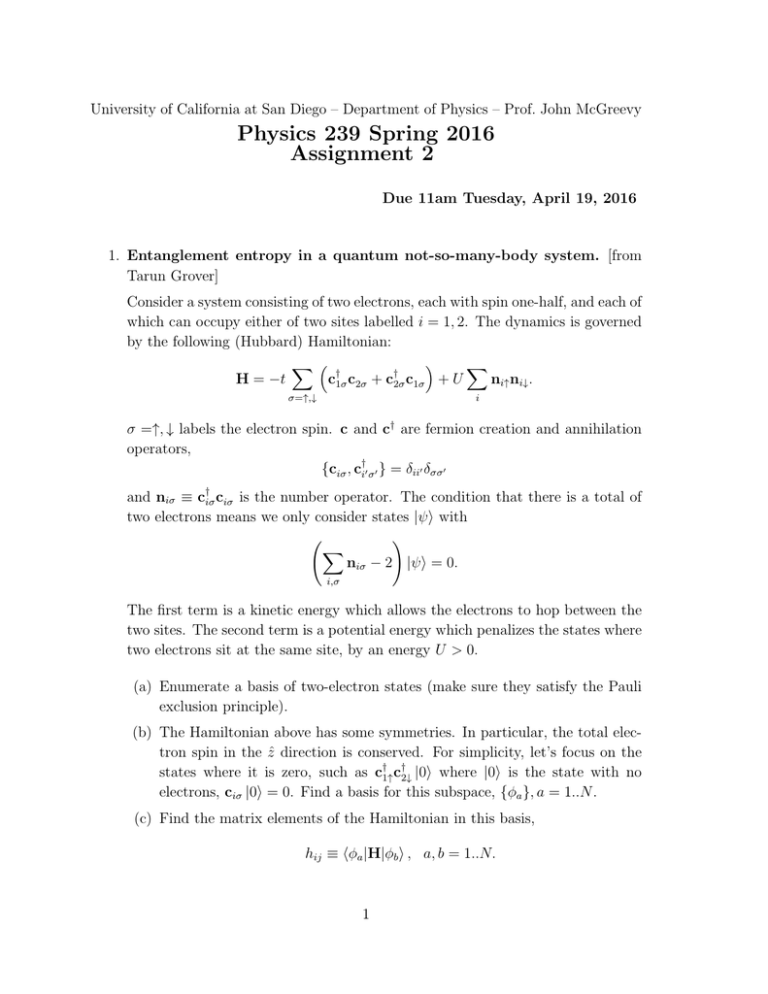
University of California at San Diego – Department of Physics – Prof. John McGreevy
Physics 239 Spring 2016
Assignment 2
Due 11am Tuesday, April 19, 2016
1. Entanglement entropy in a quantum not-so-many-body system. [from
Tarun Grover]
Consider a system consisting of two electrons, each with spin one-half, and each of
which can occupy either of two sites labelled i = 1, 2. The dynamics is governed
by the following (Hubbard) Hamiltonian:
X †
X
c1σ c2σ + c†2σ c1σ + U
H = −t
ni↑ ni↓ .
i
σ=↑,↓
σ =↑, ↓ labels the electron spin. c and c† are fermion creation and annihilation
operators,
{ciσ , c†i0 σ0 } = δii0 δσσ0
and niσ ≡ c†iσ ciσ is the number operator. The condition that there is a total of
two electrons means we only consider states |ψi with
!
X
niσ − 2 |ψi = 0.
i,σ
The first term is a kinetic energy which allows the electrons to hop between the
two sites. The second term is a potential energy which penalizes the states where
two electrons sit at the same site, by an energy U > 0.
(a) Enumerate a basis of two-electron states (make sure they satisfy the Pauli
exclusion principle).
(b) The Hamiltonian above has some symmetries. In particular, the total electron spin in the ẑ direction is conserved. For simplicity, let’s focus on the
states where it is zero, such as c†1↑ c†2↓ |0i where |0i is the state with no
electrons, ciσ |0i = 0. Find a basis for this subspace, {φa }, a = 1..N .
(c) Find the matrix elements of the Hamiltonian in this basis,
hij ≡ hφa |H|φb i , a, b = 1..N.
1
(d) Find the eigenstate and eigenvalue of the matrix h with the lowest eigenvalue. Write the groundstate as
|Ψi =
N
X
αa |φa i .
a=1
(e) Before imposing the global constraints on particle number and S z , the
Hilbert space can be factored (up to some signs because fermions are weird)
by site: H = H1 ⊗ H2 , where Hi = span{|0i , c†i↑ |0i , c†i↓ |0i , c†i↑ c†i↓ |0i}. Using this bipartition, construct the reduced density matrix for the first site
in the groundstate:
ρ1 ≡ trH2 |Ψi hΨ| .
(f) Find the eigenvalues λα of ρ1 . Calculate the von Neumann entropy of ρ1 ,
P
S(ρ1 ) = − α λα log λα as a function of U/t. What is the numerical value
when U/t → ∞?
(g) Super-Exchange. Go back to the beginning and consider the limit U t.
What are the groundstates when U/t → ∞, so that we may completely
ignore the hopping term?
At second order in degenerate perturbation theory, find the effective Hamiltonian which splits the degeneracy for small but nonzero t/U . Write the
answer in terms of the spin operator
~Si ≡ c† ~σσσ0 c 0 .
iσ
iσ
The sign is important!
(h) Redo all the previous parts for the case where the two particles are spin-half
bosons,
ciσ
biσ , [biσ , b†i0 σ0 ] = δii0 δσσ0 .
2. Chain rules.
Show that for a joint distribution of n random variables p(X1 · · · Xn ), the joint
and conditional entropies satisfy the following chain rule:
H(X1 · · · Xn ) =
n
X
H(Xi |Xi−1 · · · X1 ).
i=1
Show that the n = 2 case is the expectation of the log of the BHS of Bayes rule.
Then repeatedly apply the n = 2 case to increasing values of n.
2
3. Learning decreases ignorance only on average.
0a
Consider the joint distribution pyx =
, where y =↑, ↓ is the row index and
b b yx
x =↑, ↓ is the column index (so yx are like the indices on a matrix). Normalization
P
implies xy pxy = a + 2b = 1, so we have a one-parameter family of distributions,
labelled by b.
What is the allowed range of b?
Find the marginals for x and y. Find the conditional probabilities p(x|y) and
p(y|x).
Check that H(X|Y ) ≤ H(X) and H(Y |X) ≤ H(Y ) for any choice of b.
Show, however, that H(X|Y =↓) > H(X) for any b < 21 .
3
